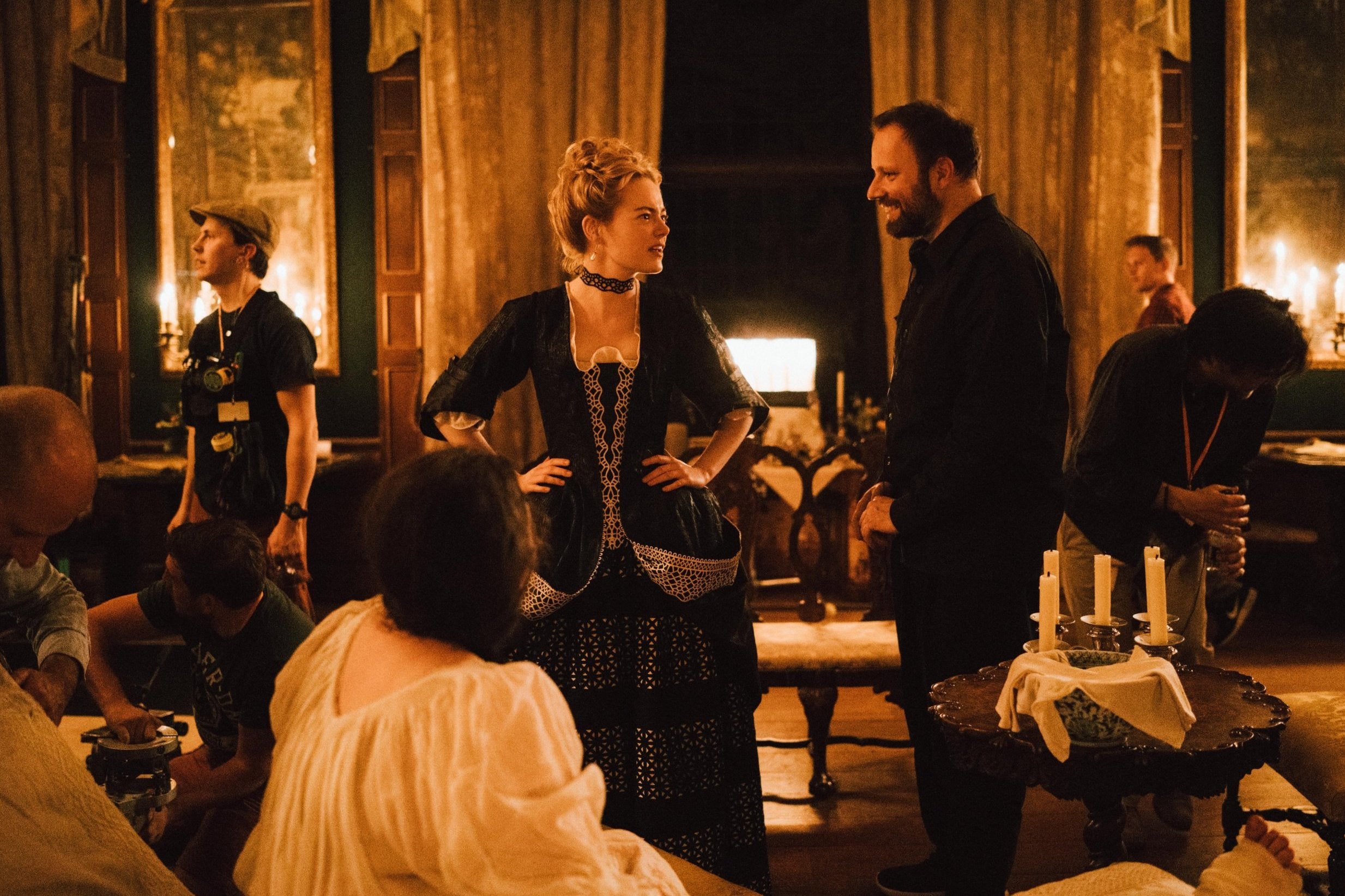The unlikely favourite: Why the rise of Yorgos Lanthimos is good news for film-lovers
Clarisse Loughrey explores the Greek director’s rise from niche oddity to box-office success and Academy Award frontrunner


The Favourite, as befits its title, has become an Academy Awards frontrunner. It’s an exquisitely costumed period piece set during the reign of Queen Anne, filmed at Hertfordshire’s Hatfield House and Hampton Court, and featuring three fearsome performances from Olivia Colman, Emma Stone and Rachel Weisz. In short, it bears all the hallmarks of a prestige drama.
Until, that is, you take into consideration its director, Yorgos Lanthimos. The man behind such eccentric offerings as The Lobster, The Killing of Sacred Deer and Dogtooth is hardly the obvious go-to for a sumptuous costume drama about an 18th-century British queen.
This is a director who, just under a decade ago, released his breakout film Dogtooth – a grim tale of isolation, incest, cat murder and DIY dentistry. It was nominated for Best Foreign Language Film at the Academy Awards, but was booed and hissed by voters during a committee screening, and ultimately lost to Susanne Bier’s In a Better World.
There’s no doubt Lanthimos will receive a much warmer reception this time around, with his tale of two cousins, Sarah (Weisz) and Abigail (Stone), battling for the affections of Queen Anne (Colman). The queen, plagued by gout and haunted by the 17 children she’s lost over the years, has basically given up governing her country.
It is Sarah who effectively does the job for her, steering Britain through yet another war with France. However, her position becomes threatened by the sudden arrival of Abigail – a woman willing to use sex, lies, and manipulation to climb the ladder to power.
The Favourite first premiered at the Venice Film Festival, which has a reputation for showcasing early awards contenders, and has already been nominated for five Golden Globes. In the US, it’s already proved popular at the box office, earning $10m (£7.8m).
The film therefore continues Lanthimos’s somewhat unexpected career trajectory. Over the course of his six films, the Greek director has broken free from his initial pigeonhole as a European oddity, acquiring global recognition and achieving significant box-office success, as well as regularly attracting Hollywood A-listers.
It’s a remarkable feat. And if Lanthimos’s surreal narratives and dark sense of humour may ultimately polarise audiences (the Amazon user reviews on any of his films can attest to that), his success continues to form a bracing challenge to the notion that cinema audiences have no appetite for originality.
His debut Kinetta, released in 2005, was made on a minuscule budget, using a handheld camera to follow the antics of its three protagonists. It displayed what was to become Lanthimos’s most dominant trait: a deep interest in physicality and movement, especially in how the human body can be made to appear entirely alien to us. In Kinetta, that was seen as the three strangers were drawn together to awkwardly stage re-enactments of a series of local murders.
Dogtooth, with its story of parents desperate to keep their children shielded from the outside world, gained the interest of Academy voters after winning the Prix Un Certain Regard at the Cannes Film Festival, but Lanthimos’s 2011 follow-up, Alps – about individuals who, for a fee, will impersonate the recently deceased to pay visit to their grieving relatives – failed to find much footing outside of the festival circuit.
However, Dogtooth’s international success had caught the eye of producers Ceci Dempsey, based in the UK, and Ed Guiney, based in Ireland, who approached Lanthimos with what would eventually become The Favourite. He, in turn, pitched them The Lobster.
Released in 2015, the film marked his English language debut, with Colin Farrell, Weisz, Colman, and John C Reilly featured in its cast. Set in a world where single people are given 45 days to find a mate, or face being permanently transformed into animals, the film was a surprise box office hit, taking in more than $18m worldwide on a $4.5m budget.
Next up for Lanthimos was The Killing of a Sacred Deer (The Favourite was still in the midst of its production process), which saw Nicole Kidman join a returning Farrell. The film centres on an unsettling acquaintance between a surgeon and a teenage boy (Barry Keoghan), the former’s world descending into chaos once the latter reveals his true motivations. It made less of a splash than its predecessor, but was still bolstered by Kidman’s presence.
The appeal of Dogtooth and The Lobster may be hard to pin down, but The Favourite is Lanthimos’s most relatable work by far, and has duly been his most enthusiastically received film. It’s also the first not to be written by him and Efthymis Filippou, his collaborator since the director’s early days in commercial work; it originated, instead, as a screenplay titled The Balance of Power, written by Deborah Davis in 1998.
The script soon attracted Dempsey’s support: she was enraptured by its “passion”, but struggled to secure financing due to its subject. Queen Anne is shown to have a sexual relationship with both Abigail and Sarah, although it’s unclear whether the latter two are sincere in their desire or simply using sex as a way to secure their own advancement. “[Studios] were like, ‘Oh, wait a minute, this is [lesbian] activity going on here’,” the producer has said of her early pitch meetings.
Happily, LGBT+ cinema is increasingly finding greater support amongst financiers and, by 2013, the film received the backing of several companies, including Film4 Productions. Once Lanthimos was onboard, he began to work closely with screenwriter Tony McNamara to adjust Davis’s script – stepping back from her focus on historical accuracy and contemporary politics, and homing in on the powerplay between the three women.
This shift is surely key to the film’s success: without the distraction of unnecessary historical detail, The Favourite opens up to become a playground for its three stars.
Lanthimos’s work has always been intimately character-focused, yet in the past this has largely been expressed through his distinctive (and divisive) approach to speech patterns. His characters are deliberately stilted and, more often than not, comically awkward. In The Killing of a Sacred Deer, the conversation is regularly interrupted with the announcement that the family’s daughter has recently had her first period, while Farrell’s character reduces all small talk to a list of facts about his new watch.
It’s an exaggeration of our own natural discomfort in the presence of others, pushed to an extreme degree – an unexpected way to make these characters vulnerable.
The characters of The Favourite, however, have a greater flair for the dramatic, allowing Queen Anne to regularly bark orders at her underlings (“Did you just look at me? Look at me! How dare you! Close your eyes!”). This is matched by Robbie Ryan’s delightfully mannered cinematography, which indulges in fish-eye lenses and strange angles, but also tends to keep the camera at arm’s length from the actors, so that the more outlandish edges of their performances are given room to breathe.
It’s a rare film where some of the best moments of acting occur in the wide shot, outside of the easy intimacy of the close-up.

By loosening the rigidity of Lanthimos’s usual approach, The Favourite has made a small concession to the conventional, allowing it find a wider cinematic audience. Yet the film could also be interpreted as simply the next step in what has been a steady rise for the director – whose success is, in fact, due to the unique nature of his work. Even here, at his most commercial, Lanthimos is simply not like anyone else.
His films can be violent and shocking (in The Lobster, a character’s punishment for masturbation involves having his hand jammed into a toaster), but he never comes across an aggressive provocateur in the manner of Lars von Trier or Michael Haneke. The extremity of his surrealism means Lanthimos’s work is also extremely funny; we’re often laughing at our own discomfort, but his sense of humour is rarely derived from a sense of cruelty. Indeed, his films are far from misanthropic, but are filled with a sense of longing, loneliness, and hurt.
His work is populated by people that represent us in our most doubtful moments, as tragic, pathetic little figures: individuals who don’t how to talk to each other, who don’t know how to have sex (scenes of intimacy are staged so coldly they feel robotic), and who don’t even know how to dance (Dogtooth’s emotional climax features the daughter’s desperate imitation of the choreography from Flashdance). And, surely, that’s something we can all relate to. No matter how strange the packaging may be.
The Favourite is released in UK cinemas on 1 January
Join our commenting forum
Join thought-provoking conversations, follow other Independent readers and see their replies
Comments